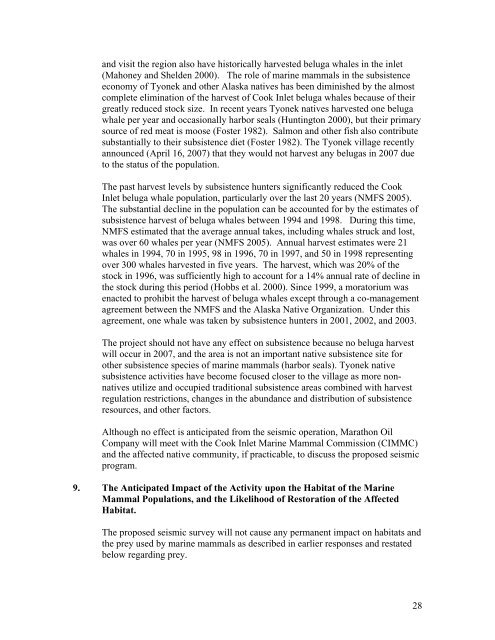IHA Application: Seismic Surveys in Cook Inlet by Marathon Oil ...
IHA Application: Seismic Surveys in Cook Inlet by Marathon Oil ...
IHA Application: Seismic Surveys in Cook Inlet by Marathon Oil ...
Create successful ePaper yourself
Turn your PDF publications into a flip-book with our unique Google optimized e-Paper software.
and visit the region also have historically harvested beluga whales <strong>in</strong> the <strong>in</strong>let<br />
(Mahoney and Shelden 2000). The role of mar<strong>in</strong>e mammals <strong>in</strong> the subsistence<br />
economy of Tyonek and other Alaska natives has been dim<strong>in</strong>ished <strong>by</strong> the almost<br />
complete elim<strong>in</strong>ation of the harvest of <strong>Cook</strong> <strong>Inlet</strong> beluga whales because of their<br />
greatly reduced stock size. In recent years Tyonek natives harvested one beluga<br />
whale per year and occasionally harbor seals (Hunt<strong>in</strong>gton 2000), but their primary<br />
source of red meat is moose (Foster 1982). Salmon and other fish also contribute<br />
substantially to their subsistence diet (Foster 1982). The Tyonek village recently<br />
announced (April 16, 2007) that they would not harvest any belugas <strong>in</strong> 2007 due<br />
to the status of the population.<br />
The past harvest levels <strong>by</strong> subsistence hunters significantly reduced the <strong>Cook</strong><br />
<strong>Inlet</strong> beluga whale population, particularly over the last 20 years (NMFS 2005).<br />
The substantial decl<strong>in</strong>e <strong>in</strong> the population can be accounted for <strong>by</strong> the estimates of<br />
subsistence harvest of beluga whales between 1994 and 1998. Dur<strong>in</strong>g this time,<br />
NMFS estimated that the average annual takes, <strong>in</strong>clud<strong>in</strong>g whales struck and lost,<br />
was over 60 whales per year (NMFS 2005). Annual harvest estimates were 21<br />
whales <strong>in</strong> 1994, 70 <strong>in</strong> 1995, 98 <strong>in</strong> 1996, 70 <strong>in</strong> 1997, and 50 <strong>in</strong> 1998 represent<strong>in</strong>g<br />
over 300 whales harvested <strong>in</strong> five years. The harvest, which was 20% of the<br />
stock <strong>in</strong> 1996, was sufficiently high to account for a 14% annual rate of decl<strong>in</strong>e <strong>in</strong><br />
the stock dur<strong>in</strong>g this period (Hobbs et al. 2000). S<strong>in</strong>ce 1999, a moratorium was<br />
enacted to prohibit the harvest of beluga whales except through a co-management<br />
agreement between the NMFS and the Alaska Native Organization. Under this<br />
agreement, one whale was taken <strong>by</strong> subsistence hunters <strong>in</strong> 2001, 2002, and 2003.<br />
The project should not have any effect on subsistence because no beluga harvest<br />
will occur <strong>in</strong> 2007, and the area is not an important native subsistence site for<br />
other subsistence species of mar<strong>in</strong>e mammals (harbor seals). Tyonek native<br />
subsistence activities have become focused closer to the village as more nonnatives<br />
utilize and occupied traditional subsistence areas comb<strong>in</strong>ed with harvest<br />
regulation restrictions, changes <strong>in</strong> the abundance and distribution of subsistence<br />
resources, and other factors.<br />
Although no effect is anticipated from the seismic operation, <strong>Marathon</strong> <strong>Oil</strong><br />
Company will meet with the <strong>Cook</strong> <strong>Inlet</strong> Mar<strong>in</strong>e Mammal Commission (CIMMC)<br />
and the affected native community, if practicable, to discuss the proposed seismic<br />
program.<br />
9. The Anticipated Impact of the Activity upon the Habitat of the Mar<strong>in</strong>e<br />
Mammal Populations, and the Likelihood of Restoration of the Affected<br />
Habitat.<br />
The proposed seismic survey will not cause any permanent impact on habitats and<br />
the prey used <strong>by</strong> mar<strong>in</strong>e mammals as described <strong>in</strong> earlier responses and restated<br />
below regard<strong>in</strong>g prey.<br />
28
















